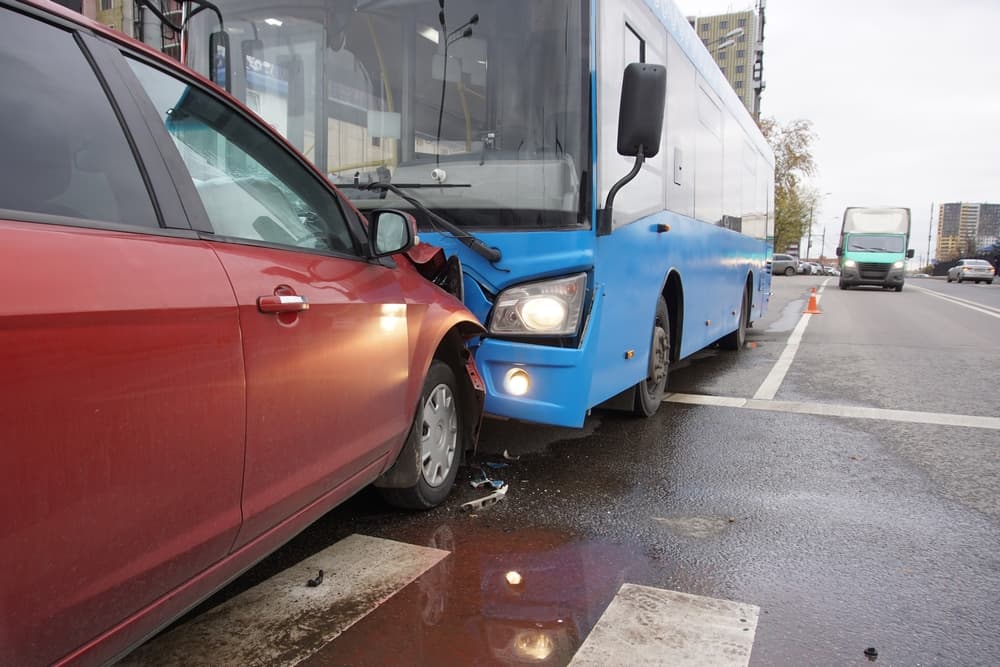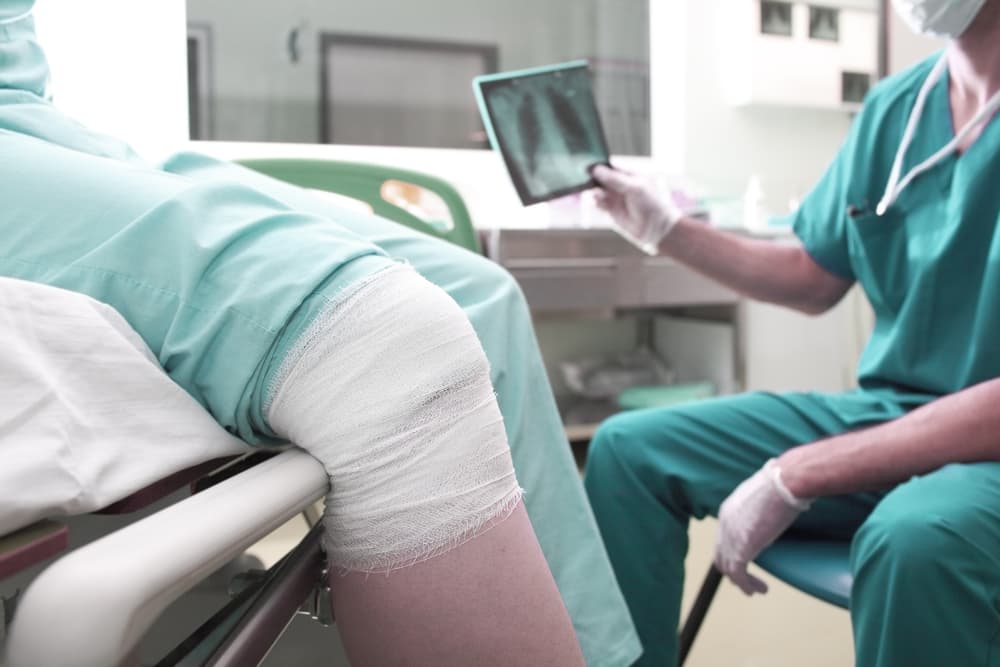Bus accidents frequently happen when drivers fail to watch the road attentively, speed, engage in distracted driving, or commit other traffic law violations. When bus passengers and others suffer injuries, they may be eligible to recover compensation for their various losses.
If you recently sustained injuries in a collision involving a school bus, city bus, municipal bus, or charter bus, you need to speak with a knowledgeable bus accident lawyer in Edmonton right away. Your lawyer can obtain the documents necessary to investigate your case and take steps to pursue the financial compensation you deserve for your injuries.
Common Bus Accident Types and Causes
Bus accidents, unfortunately, occur due to various factors and can result from different types of incidents. One prevalent type is the rear-end collision, often transpiring when a bus follows a vehicle too closely or fails to stop in time. Such accidents frequently result from driver distraction, inadequate braking, or adverse weather conditions, leading to a collision with the vehicle ahead.
Another common type of bus accident involves collisions while making turns. These incidents often stem from the bus driver misjudging the space required for the turn – or failing to yield to other vehicles and pedestrians. Inadequate training or poor visibility may contribute to these accidents, posing risks to both passengers on the bus and others sharing the road.
Intersection accidents are also frequent occurrences involving buses. These accidents typically unfold when a bus driver fails to yield the right-of-way or disobeys traffic signals, leading to collisions with vehicles crossing the intersection. Inattention, misjudgment of distances, or mechanical failures can contribute to these incidents, highlighting the importance of driver attentiveness and adherence to common traffic rules.
Moreover, bus accidents can result from sudden lane changes. When a bus driver abruptly changes lanes without signaling or checking blind spots, it can lead to collisions with other vehicles. Driver negligence, distraction, or insufficient awareness of the bus’s blind spots contribute to the risk of these accidents, emphasizing the need for proper signaling and careful lane-changing practices.
Bus rollovers represent a particularly severe type of accident. These incidents often occur due to factors such as high speeds, sharp turns, or uneven road surfaces. Inadequate maintenance, tire blowouts, or driver fatigue can also contribute to the risk of a bus rollover, emphasizing the importance of proper vehicle maintenance and driver rest.

Additionally, bus accidents may involve pedestrians or cyclists. Failure to yield to pedestrians at crosswalks, unsafe bus stops, or improper merging onto bike lanes can lead to collisions with vulnerable road users. Bus drivers must always use extreme caution and awareness – particularly in areas with high pedestrian or cyclist traffic.
In general, the most common types and causes of bus accidents encompass rear-end collisions, turning accidents, intersection incidents, sudden lane changes, rollovers, and collisions involving pedestrians or cyclists. If you recently sustained injuries in one of these types of bus collisions, an experienced bus accident lawyer can thoroughly investigate your accident circumstances and pursue a claim with the appropriate insurance company.
What are the Most Common Injuries in a Bus Accident?
In the unfortunate event of a bus accident, individuals may sustain various common injuries, each with its own set of challenges. One common type of bus accident injury is whiplash, which often occurs in rear-end collisions or with sudden stops. Whiplash involves the sudden forward and backward movement of the accident victim’s neck, leading to strains and sprains that can result in lingering pain and restricted mobility.

Traumatic brain injuries (TBIs) are also common in bus accidents, particularly when passengers are thrown or jolted during a collision. TBIs can range from concussions to more severe forms, impacting cognitive functions and sometimes causing long-term consequences. The risk of TBIs emphasizes the importance of proper restraint systems and overall safety measures on buses.
Bone fractures are also common in bus accidents, especially during collisions or rollovers. Passengers may suffer fractures in their limbs, pelvis, or spine, leading to pain, immobility, and the need for extensive medical intervention. The severity of fractures varies, but their effect on an individual’s daily life can be significant.
Soft tissue injuries, such as contusions, lacerations, and bruises, are also common outcomes of bus accidents. These injuries can result from the force of impact, sharp objects within the bus, or collisions with other passengers or objects. While they may not always be life-threatening, these injuries can cause pain and discomfort, requiring medical attention and potential rehabilitation.
Serious bus accidents can also lead to spinal cord injuries, particularly in rollover incidents or severe collisions. Spinal cord injuries can result in varying degrees of full or partial paralysis, affecting motor and sensory functions. The long-term consequences of spinal cord injuries often require extensive medical care, rehabilitation, and lifestyle adjustments for affected individuals.
In addition to physical injuries, bus accidents can take a toll on individuals’ mental health. Post-traumatic stress disorder (PTSD) is a common psychological consequence – especially for those who experience the trauma of a bus accident. Anxiety, depression, and other mental health challenges may arise, requiring appropriate counselling and support services.
The most common injuries individuals may suffer in a bus accident include whiplash, traumatic brain injuries, bone fractures, soft tissue injuries, and spinal cord injuries. If you recently suffered one or more of these injuries in a bus collision, a bus accident lawyer in your area can begin handling your personal injury claim while you complete your medical treatment regimen.
What are the Legal Elements of a Bus Accident Case?
Proving the legal elements of a bus accident claim or lawsuit requires a thorough approach focused on establishing key factors. One fundamental element is demonstrating negligence, which is typically attributable to the bus driver, bus company, or entity responsible for bus maintenance. This involves showing that the responsible party failed to use reasonable care, directly causing the accident and subsequent injuries.
Causation plays an important role in substantiating a bus accident claim. It requires establishing a clear link between the negligent actions of the responsible party and the injuries that the accident victim suffered. Demonstrating that the injuries were a direct result of the negligent behaviour is crucial in establishing the causal relationship between the accident and the harm sustained.
Furthermore, proving actual damages is essential to building a strong personal injury case. This involves documenting tangible losses that the victim incurred due to the bus accident, such as lost income, loss of earning capacity, or pain and suffering. The severity of the injuries and the resulting effect on the victim’s life may affect the calculation of these damages, highlighting the need for thorough documentation.
Medical evidence is essential when proving the extent of injuries resulting from the bus accident. This includes detailed medical records, expert opinions, and testimony from healthcare professionals. Presenting this evidence establishes the severity and permanence of the injuries, highlighting the victim’s need for favourable compensation.
Eyewitness statements and accident reconstruction reports may also serve as evidence in the case. Eyewitness accounts provide additional perspectives on the events leading up to the bus accident, while accident reconstruction experts often use scientific methods to recreate the sequence of events. These types of evidence frequently increase the credibility and strength of the victim’s overall case.
An experienced bus accident lawyer can gather the necessary documentary evidence and retain the necessary experts to satisfy your legal burden of proof.
Fighting the Insurance Company after a Bus Accident
When pursuing a legal claim for a bus accident resulting from negligence, a skilled bus accident lawyer plays an important role in challenging the insurance company to obtain fair compensation for the victim.
- First, the lawyer diligently investigates the accident, gathering evidence to prove the claim of negligence. This involves reviewing accident reports, collecting witness statements, and consulting with accident reconstruction experts to build a solid case foundation. By proactively gathering compelling evidence, the lawyer lays the groundwork for challenging the insurance company’s potential attempts to dismiss or downplay the claim.
- The lawyer then communicates with the insurance company, presenting a compelling demand package. This package includes a detailed account of the accident, the injuries sustained, and a calculation of damages. Clear and persuasive communication is essential to demonstrate the merit of the claim and assert the accident victim’s right to fair compensation.
- Engaging in negotiations with the insurance company is a key aspect of the lawyer’s role. Through strategic discussions, the lawyer leverages the strength of the evidence and legal arguments to advocate for a settlement that adequately addresses the victim’s damages.
- If negotiations prove unsuccessful – or if the insurance company remains uncooperative – the bus accident lawyer may pursue legal action by filing a lawsuit. The lawyer then navigates the litigation process, sometimes presenting the case in court to secure a favourable verdict for the accident victim. Litigation involves thorough legal arguments, the presentation of evidence, and the ability to articulate the at-fault party’s negligence to the court.
- Throughout the litigation process, a bus accident lawyer will prioritize the interests and well-being of the injured accident victim. By using a strategic approach, the lawyer can overcome the challenges that the insurance company presents and recover a monetary award that makes the victim whole again.
A bus accident lawyer actively fights the insurance company by investigating the accident, presenting a compelling demand package, engaging in strategic negotiations, and, if necessary, pursuing litigation. The lawyer’s proactive approach is geared towards securing justice and fair compensation for the accident victims and advocating for their rights throughout the legal process.
Recovering Fair Damages in a Bus Accident Claim or Lawsuit
When pursuing a personal injury claim or lawsuit following a bus accident, victims may be eligible for various types of financial compensation that aim to address the extensive effect of the incident on their lives. One significant aspect is compensation for lost income, which considers the potential impact of the bus accident on the victim’s ability to work. This involves accounting for income that the victim lost during their recovery period – and any future earning capacity resulting from their long-term injuries or disabilities.
Loss of earning capacity is a separate category of compensation that addresses the more profound effect on an individual’s ability to earn a living. If the bus accident leads to disabilities or restrictions that hinder the victim’s career opportunities, this compensation seeks to offset the financial consequences of a diminished earning capacity over the long term.
In some cases, punitive damages may also be available to the accident victim. These damages are necessary to punish the responsible party for egregious negligence or intentional misconduct, acting as a deterrent against similar wrongful actions in the future. Punitive damages may apply in situations where the at-fault party’s conduct goes beyond mere negligence.
Various non-economic damages – reflecting the intangible losses that the bus accident victim suffered – also play an important role in financial compensation. Pain and suffering compensation encompasses the victim’s physical and emotional distress resulting from the bus accident and aims to address the subjective toll on the victim’s well-being. Emotional distress, mental anguish, and loss of life enjoyment are all considerations in determining non-economic damages.
Loss of consortium compensation acknowledges the effect of the injuries on a victim’s relationships with others. This includes the strain on familial and spousal relationships due to the physical and emotional consequences of the bus accident.
The various types of financial compensation for a bus accident victim encompass lost income, loss of earning capacity, punitive damages, pain and suffering, emotional distress, and loss of consortium. Each element strives to address the comprehensive effect of the accident on the victim’s life and alleviate financial, emotional, and relational burdens.
Call a Knowledgeable Bus Accident Lawyer Near You Today

If you suffered injuries in a bus accident that resulted from someone else’s negligence, an Edmonton personal injury lawyer in your area can handle the legal components of your case while you concentrate on getting better. Specifically, your lawyer can thoroughly investigate the bus accident circumstances, file a claim with the bus driver or bus company’s insurer, and settle or litigate your case to a favourable resolution.
